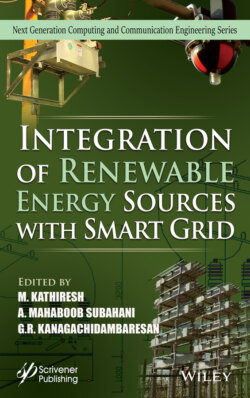Читать книгу Integration of Renewable Energy Sources with Smart Grid - Группа авторов - Страница 51
2.7 Wind Energy
ОглавлениеMankind has always been fascinated by the power of wind. Wind energy is one of the most exploitable forms of energy. From time immemorial, wind power is used for mechanical applications such as water pumping and milling. Professor James Blyth was known to be the first person to successfully produce electricity from wind power in 1887. As of 2019, the total installed capacity of wind power has grown to 651 GW [15].
The kinetic energy in the wind is used to rotate the blades of the rotor which is then used to rotate electrical generators to produce electrical power. The power contained in the wind is proportional to the cube of wind velocity. Therefore, if the wind speed is reduced by 2 percent then there will be an 8% reduction in the power output of the windmill. The place with strong wind is ideal for wind power plants. Generally, the wind speeds increase in fraction as the height increases. Not all the power in the windmill can be converted in to electrical power. Wind turbines are usually place at height of 400 ft. Wind energy is a low quality energy. Theoretically, one extracts a maximum of 16/27th of the total power contained in the wind irrespective of type of wind turbine. This limit is called the Betz limit or Betz coefficient.
Individual wind turbines have an average rating of 3 MW. Many individual wind turbines are connected to form a wind farm. A farm may contain few wind turbines to a large number of wind turbines built over a vast area both onshore as well offshore. Gansu wind farm of china is the largest of its kind in the world. India with an installed capacity of 37.5 GW stands fifth in the world wind power and second in the Asian countries.
Muppandal wind farm spread over Kanyakumari district of Tamil Nadu is the second largest wind farm in the world with 3,000 wind turbines to generate nearly 1,500 MW of electrical power. Tamil Nadu is the leader in wind power installation in India with installed capacity of 7,633 MW which account for 29% of India’s total wind energy installations. Gujarat has the highest wind energy potential of 142.6 GW.
The Government of India is keen in enhancing the wind energy sector. National Institute of Wind Energy is established under the aegis of Ministry of New and Renewable Energy sources which carry out activities like wind energy resource, testing, and certification.
Like solar, wind is a highly intermittent source of energy. This poses challenges in grid operation. Mostly, wind energy sites are located far away from the load site which necessitated the establishment of a complex transmission network. The tall structure is visually blocking the aesthetic of the area. Noise pollution is also caused by its blades.
Adequate investment in capacity and efficient working of transmission and distribution systems in developing economies with high growth of electricity demand are important objectives. Market oriented reform processes are required both for the creation of capacity and for electricity as a product. This invariably requires unbundling of transmission and distribution capacities from generation capacities. The importance of such systems for interregional grids across national borders and the superiority of rule-based systems as compared to Bismarckian diplomatic negotiations needs exploration.
Problems of technical management of efficient transmission and distribution systems and in particular of integrating decentralized generation through mini hydel, wind, or PV sustainable generation mechanisms with grids are of interest. In addition to the national level, the integration of such systems with reform at the global level, including the OECD and G20 requires to be explored to integrate state-of-the-art practice in the reform process.
